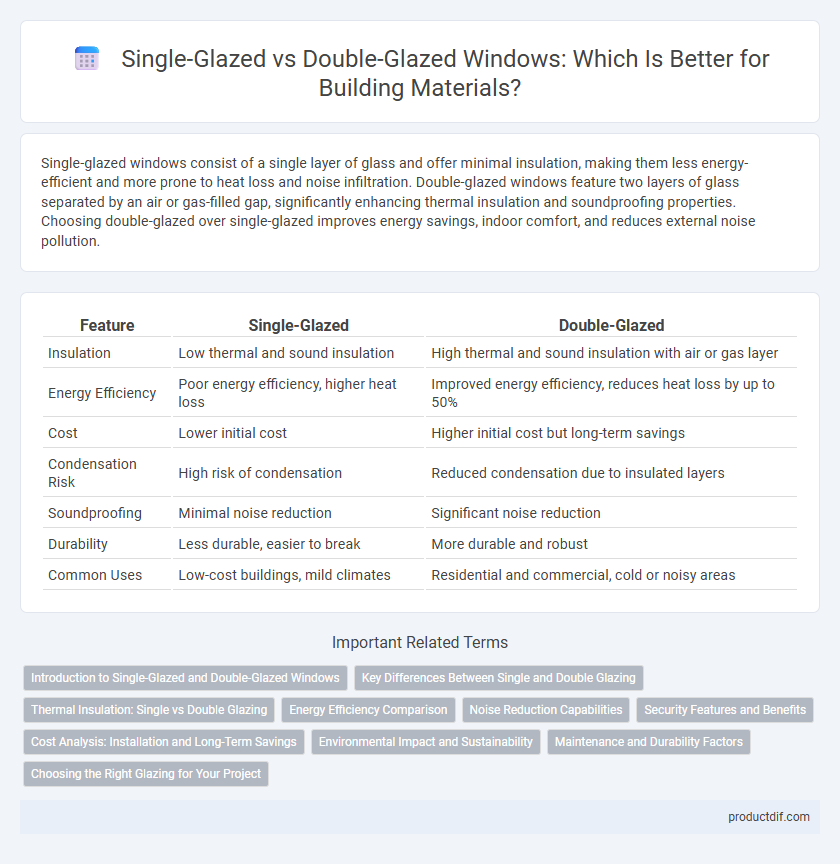Single-glazed windows consist of a single layer of glass and offer minimal insulation, making them less energy-efficient and more prone to heat loss and noise infiltration. Double-glazed windows feature two layers of glass separated by an air or gas-filled gap, significantly enhancing thermal insulation and soundproofing properties. Choosing double-glazed over single-glazed improves energy savings, indoor comfort, and reduces external noise pollution.
Table of Comparison
| Feature | Single-Glazed | Double-Glazed |
|---|---|---|
| Insulation | Low thermal and sound insulation | High thermal and sound insulation with air or gas layer |
| Energy Efficiency | Poor energy efficiency, higher heat loss | Improved energy efficiency, reduces heat loss by up to 50% |
| Cost | Lower initial cost | Higher initial cost but long-term savings |
| Condensation Risk | High risk of condensation | Reduced condensation due to insulated layers |
| Soundproofing | Minimal noise reduction | Significant noise reduction |
| Durability | Less durable, easier to break | More durable and robust |
| Common Uses | Low-cost buildings, mild climates | Residential and commercial, cold or noisy areas |
Introduction to Single-Glazed and Double-Glazed Windows
Single-glazed windows consist of a single pane of glass, offering basic insulation and minimal soundproofing. Double-glazed windows feature two panes of glass separated by an air or gas-filled space, significantly improving thermal insulation and energy efficiency. The enhanced design of double-glazed units reduces heat loss and noise infiltration, making them ideal for energy-conscious building projects.
Key Differences Between Single and Double Glazing
Single-glazed windows consist of a single glass pane, resulting in lower insulation performance and higher heat transfer rates compared to double-glazed windows that feature two glass panes separated by an air or gas-filled cavity. Double glazing significantly improves thermal efficiency, reduces condensation, and enhances soundproofing, making it ideal for energy-saving building designs. Choosing double-glazed windows contributes to lower heating and cooling costs by minimizing heat loss and gain through window surfaces.
Thermal Insulation: Single vs Double Glazing
Double-glazed windows provide significantly better thermal insulation than single-glazed options by trapping air or inert gas between two glass panes, reducing heat transfer and improving energy efficiency. Single glazing allows more heat to escape or enter due to its single pane, leading to higher heating and cooling costs. The enhanced insulation of double glazing helps maintain indoor temperatures, reduces condensation, and lowers overall energy consumption in buildings.
Energy Efficiency Comparison
Double-glazed windows provide superior energy efficiency compared to single-glazed windows by reducing heat transfer through their two layers of glass separated by an insulating air or gas-filled gap. This design minimizes heat loss in winter and heat gain in summer, resulting in lower energy consumption for heating and cooling. Single-glazed windows lack this insulation, leading to higher energy bills and less effective temperature regulation.
Noise Reduction Capabilities
Double-glazed windows offer significantly better noise reduction capabilities compared to single-glazed windows due to their two layers of glass separated by an air or gas-filled cavity that acts as an effective sound barrier. Single-glazed windows allow more external noise to penetrate, making them less ideal for environments with high noise pollution such as urban areas or near busy roads. The improved acoustic insulation of double glazing enhances indoor comfort by minimizing the transmission of street noise and other external sounds.
Security Features and Benefits
Double-glazed windows provide enhanced security by incorporating two layers of glass with a strong air or gas-filled space in between, making them significantly harder to break compared to single-glazed windows. The added thickness and sturdiness of double glazing act as a deterrent against forced entry, improving home safety and reducing the risk of intrusions. Single-glazed windows, consisting of only one glass layer, lack this reinforced barrier, offering minimal resistance to impact and compromising overall security.
Cost Analysis: Installation and Long-Term Savings
Single-glazed windows typically have lower installation costs, averaging $100 to $300 per window, while double-glazed windows range from $200 to $600 due to added materials and complexity. Over the long term, double-glazed windows offer significant energy savings by reducing heat loss up to 50%, which can lower heating and cooling bills by 15% to 25%. Investing in double glazing enhances property value and reduces maintenance costs, making it a cost-effective choice despite higher upfront expenses.
Environmental Impact and Sustainability
Single-glazed windows have lower insulation properties, leading to higher energy consumption for heating and cooling, which increases carbon emissions. Double-glazed windows significantly improve thermal efficiency by reducing heat loss and gain, thereby decreasing reliance on fossil fuels and lowering greenhouse gas emissions. Investing in double-glazed units supports sustainable building practices by enhancing energy conservation and reducing the overall environmental footprint.
Maintenance and Durability Factors
Single-glazed windows require more frequent maintenance due to their susceptibility to condensation and heat loss, which can cause frame deterioration over time. Double-glazed windows offer enhanced durability with improved insulation layers that protect against weather extremes and reduce the risk of glass breakage. Investing in double glazing reduces long-term maintenance costs and extends the lifespan of window installations in various building environments.
Choosing the Right Glazing for Your Project
Single-glazed windows consist of a single pane of glass, offering basic insulation and affordability, while double-glazed windows feature two glass panes separated by an insulating layer, significantly enhancing thermal performance and noise reduction. Selecting double-glazed glazing for your project improves energy efficiency, reduces heating and cooling costs, and increases property value, making it ideal for climates with extreme temperatures or noise concerns. Single-glazed options may be suitable for temporary structures or budget-conscious projects where insulation is less critical.
Single-glazed vs Double-glazed Infographic

 productdif.com
productdif.com